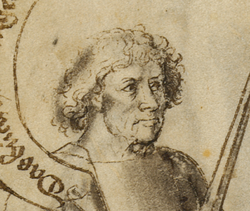|
|
You are not currently logged in. Are you accessing the unsecure (http) portal? Click here to switch to the secure portal. |
Wiktenauer:Main page/Featured
| Hans Talhoffer | |
|---|---|
 | |
| Born | ca. 1410-15 Swabia |
| Died | after 1482 |
| Occupation | |
| Patron |
|
| Movement | Marxbrüder (?) |
| Genres | |
| Language | Early New High German |
| Archetype(s) |
MS Thott 290.2º (1459)
|
| Manuscript(s) |
Cod. I.6.2º.1 (before 1561)
|
Hans Talhoffer (Dalhover, Talhouer, Thalhoffer, Talhofer) was a 15th century German fencing master. His martial lineage is unknown, but his writings make it clear that he had some connection to the tradition of Johannes Liechtenauer, the grand master of the German school of fencing. Talhoffer was a well educated man, who took interest in astrology, mathematics, onomastics, and the auctoritas and the ratio. He authored at least five fencing manuals during the course of his career, and appears to have made his living teaching, including training people for trial by combat.
The first historical reference to Talhoffer is in 1433, when he represented Johann II von Reisberg, archbishop of Salzburg, before the Vehmic court. Shortly thereafter in 1434, Talhoffer was arrested and questioned by order of Wilhelm von Villach (a footman to Albrecht III von Wittelsbach, duke of Bavaria) in connection to the trial of a Nuremberg aristocrat named Jacob Auer, accused of murdering of his brother Hans. Talhoffer subsequently confessed to being hired to abduct Hans von Villach, and offered testimony that others hired by Auer performed the murder. Auer's trial was quite controversial and proved a major source of contention and regional strife for the subsequent two years. Talhoffer himself remained in the service of the archbishop for at least a few more years, and in 1437 is mentioned as serving as a bursary officer (Kastner) in Hohenburg.
The 1440s saw the launch of Talhoffer's career as a professional fencing master. He purchased (and perhaps contributed to) the MS Chart.A.558, an anthology created in ca. 1448. The fencing portion is largely text-less and it may have been designed as a visual aid for use in teaching; in addition to these illustrations, the manuscript also contains a treatise on name magic and a warbook that might be related to Konrad Kyeser's Bellifortis. While Talhoffer's owner's mark appears in this manuscript, his level of involvement with its creation is unclear. It contains many works by other authors, in addition to plays that are somewhat similar to his later works, and shows evidence of multiple scribes and multiple artists. It is possible that he purchased the manuscript after it was completed (or partially completed), and used it as a basis for his later teachings.
Most notable among the noble clients that Talhoffer served in this period was the Königsegg family of southern Germany, and some time between 1446 and 1459 he produced the MS XIX.17-3 for this family…
(Read more…)
- Recently Featured:
- Andre Lignitzer – Adam van Breen – Die Blume des Kampfes – Francesco Fernando Alfieri
